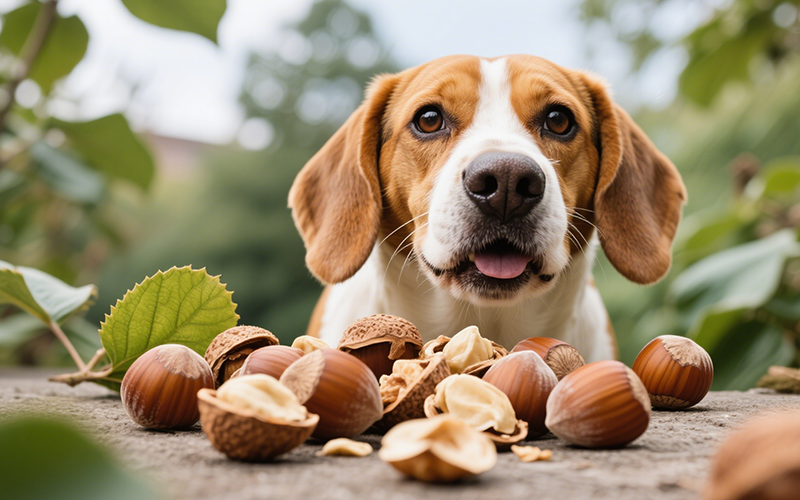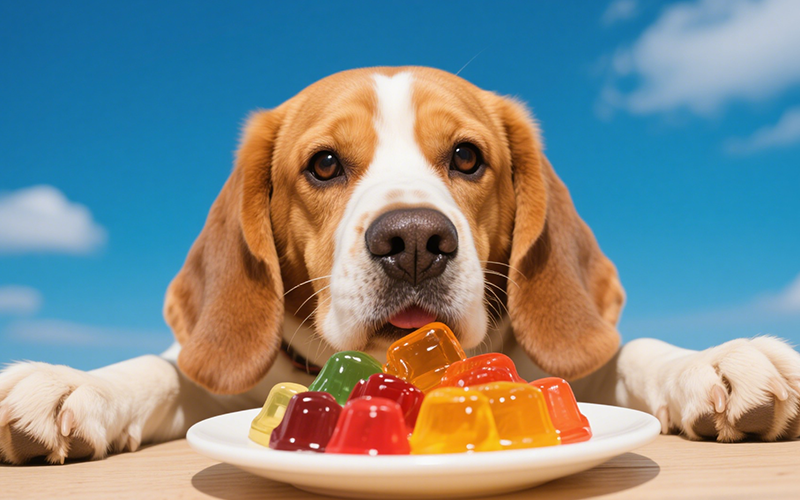Can Dogs Eat Hazelnuts? Vet Explains Potential Risks & Safe Alternatives
- 15 Apr 2025 10:52
As we enjoy a handful of crunchy, flavorful nuts, it's common for our canine companions to show interest, hoping for a dropped morsel or a shared treat. Hazelnuts, popular in trail mixes, desserts, and spreads like Nutella, might seem like a harmless option compared to more well-known toxic nuts like macadamias. This leads conscientious pet owners to ask: can dogs eat hazelnuts? While hazelnuts are **not considered toxic** to dogs in the same way macadamia nuts or grapes are, they are generally **not recommended** by veterinarians. Their size, shape, and high fat content pose potential risks that often outweigh any minor nutritional benefit.
This comprehensive guide, drawing on veterinary nutritional knowledge and adhering to E-E-A-T (Expertise, Authoritativeness, Trustworthiness) standards, will delve into the specific reasons why hazelnuts aren't an ideal treat for dogs. We'll explore the potential dangers, including choking and obstruction risks, gastrointestinal upset, pancreatitis concerns, and issues with harmful preparations, while also suggesting safer alternatives for your furry friend.

What Are Hazelnuts? A Quick Look
Hazelnuts, also known as filberts, are nuts produced by the hazel tree (genus Corylus). They have a smooth, hard shell that encloses a rounded kernel (the part we eat). They are enjoyed raw, roasted, or ground into paste and are known for their distinct, slightly sweet flavor.
Nutritionally for humans, they are a good source of:
Healthy Fats (mostly monounsaturated)
Protein
Dietary Fiber
Vitamin E
Manganese
Copper
Magnesium
However, their nutritional profile for humans doesn't directly translate to suitability for dogs.
Are Hazelnuts Toxic to Dogs? Clarifying the Safety
The good news is that hazelnuts **do not contain any known specific toxins** that cause poisoning in dogs, unlike macadamia nuts (which cause neurological issues) or black walnuts (which can contain tremorgenic mycotoxins). If your dog accidentally eats one or two plain, unsalted, shelled hazelnuts, it's unlikely to cause a severe toxic reaction.
However, this lack of inherent toxicity **does not make them safe or recommended**. Several other factors make hazelnuts a poor and potentially dangerous choice for dogs:
Physical Hazard:** Their size and shape pose a significant risk.
High Fat Content:** Can lead to digestive and pancreatic issues.
Potential for Mold:** Like many nuts.
Harmful Preparations:** Often salted, coated, or mixed with toxic ingredients.
So, while not poisonous, the answer to "are hazelnuts safe for dogs?" leans towards no due to these considerable risks.
Major Risks & Dangers of Feeding Hazelnuts to Dogs
Despite not being toxic, intentionally feeding hazelnuts introduces several potential hazards:
1. Choking and Intestinal Obstruction Hazard (Significant Risk!)
This is arguably the **most significant danger**, especially for small and medium-sized dogs.
Size and Shape:** Hazelnuts are small, round, and hard. They are perfectly sized to become lodged in a dog's esophagus (causing choking) or further down in the digestive tract (causing intestinal obstruction).
Choking Emergency:** Airway obstruction is life-threatening and requires immediate intervention (canine Heimlich maneuver, emergency vet visit).
Intestinal Blockage: If swallowed whole, a hazelnut can easily get stuck, particularly in the narrow small intestine, preventing the passage of food and fluids. This causes severe pain, persistent vomiting, loss of appetite, and lethargy. Surgical removal is typically required, which is invasive and costly.
Shell Danger:** If ingested with the hard outer shell still on (though less common for human snacks), the risk of obstruction and potential internal injury increases dramatically.
The physical hazard alone makes hazelnuts a risky item, especially for smaller dogs.
2. High Fat Content: Pancreatitis & GI Upset Risk
Hazelnuts are rich in fats, primarily monounsaturated fats.
Pancreatitis Trigger: While perhaps slightly lower in fat than macadamias or pecans, hazelnuts are still very high in fat compared to what a dog's system is ideally suited for. High-fat foods are a primary trigger for pancreatitis – a painful, potentially severe inflammation of the pancreas that often requires hospitalization. Even a few nuts could potentially trigger an episode in susceptible dogs.
Gastrointestinal Distress: The high fat content can easily overwhelm a dog's digestive system, leading to vomiting, diarrhea, gas, and abdominal discomfort, even if full pancreatitis doesn't develop.
Obesity: Nuts are calorie-dense due to fat. Feeding them contributes excess calories, promoting weight gain and obesity with its associated health risks (arthritis, diabetes, heart disease).
The fat content in hazelnuts poses both acute (pancreatitis, GI upset) and chronic (obesity) risks.
3. Potential for Mold (Aflatoxins)
Like all nuts, hazelnuts stored improperly (especially in warm, humid conditions) can develop mold. Certain molds produce **aflatoxins**, which are potent toxins extremely harmful to the liver.
Risk: Ingesting moldy nuts can lead to aflatoxin poisoning, causing symptoms like lethargy, loss of appetite, vomiting, jaundice (yellowing of skin/eyes), bloody diarrhea, and potentially severe liver failure.
Prevention: While quality control minimizes this risk in human-grade nuts, it's an inherent potential danger with feeding nuts not specifically processed and tested for pet consumption. Never feed nuts that look or smell moldy.
4. High Phosphorus Content
Hazelnuts contain a fair amount of phosphorus. While essential, excess phosphorus intake can be detrimental for dogs with **kidney disease**, as their kidneys struggle to filter it effectively.
5. Harmful Preparations and Coatings
Hazelnuts intended for human snacking are often prepared in ways that add significant risks for dogs:
Salted Hazelnuts: Extremely high in sodium, dangerous for dogs (risk of dehydration, GI upset, sodium poisoning).
Chocolate-Covered Hazelnuts: Chocolate is toxic to dogs.
Candied/Honey-Roasted Hazelnuts: High in added sugar, contributing to obesity, dental problems, and GI upset.
Nut Mixes: Often contain truly toxic nuts (like macadamia nuts) or other harmful ingredients (like raisins - toxic!). It's impossible to guarantee safety when feeding from a mix.
Nutella & Similar Spreads: While containing hazelnut paste, these spreads are loaded with sugar, unhealthy fats (often palm oil), sometimes dairy, and potentially **chocolate or even xylitol** (check labels!). They are absolutely unsuitable for dogs.
Always avoid salted, coated, or flavored nuts, and never feed mixed nuts.
Nutritional Benefits? Minimal and Outweighed by Risks
While hazelnuts contain Vitamin E, magnesium, copper, fiber, and protein, these are readily available in safer forms within a dog's complete and balanced diet. The potential minor contribution from a hazelnut is insignificant compared to the substantial risks of choking, obstruction, pancreatitis, and potential toxicity from coatings or mold.
There is **no nutritional need** for dogs to eat hazelnuts.
"But My Dog Ate One!" What To Do If Your Dog Eats Hazelnuts
Accidents happen. If your dog eats hazelnuts:
Determine Quantity and Type: How many were eaten? Were they plain, salted, coated? Shelled or unshelled?
Remove Access: Prevent further ingestion.
Assess Immediate Danger: Is your dog choking? (Requires immediate Heimlich/emergency vet).
Consider the Size of Your Dog: A single plain, shelled hazelnut eaten by a very large dog *might* pass without incident (though still not ideal). The same nut poses a significant obstruction risk to a small dog.
Contact Your Veterinarian For Advice:** Especially if:
More than one or two nuts were eaten.
The nuts were salted or coated (especially chocolate).
Your dog is small or medium-sized (higher obstruction risk).
Your dog has a history of pancreatitis, GI sensitivity, or kidney disease.
You observe *any* signs of distress: gagging, difficulty swallowing, vomiting, diarrhea, lethargy, abdominal pain.
Provide Details:** Tell the vet the number/type of nuts, time eaten, dog's details, and symptoms.
Follow Vet Instructions:** They may recommend monitoring at home (for minimal ingestion in large dogs), inducing vomiting (rarely for solid objects unless very recent), diagnostic imaging (X-rays for obstruction), or supportive care.
Do not hesitate to call your vet, as obstruction is a key concern.
Safe Treat Alternatives Your Dog Will Love
Swap risky hazelnuts for these safe and healthy options:
| Treat Option | Why It's Better Than Hazelnuts |
| Hazelnuts | UNSAFE: Choking/Obstruction Hazard, High Fat (Pancreatitis), Potential Mold, High Calories/Phosphorus. Avoid. |
| Commercial Dog Biscuits (High Quality) | Designed for dogs, appropriate texture, balanced (as treats). Choose reputable brands, check ingredients. Excellent safe crunchy alternative. |
| Dog-Safe Vegetables (e.g., Carrot Sticks, Green Beans, Cucumber Slices) | Low calorie, provide fiber/vitamins, safe crunch (carrots), hydrating (cucumber). Very safe. |
| Dog-Safe Fruits (e.g., Blueberries, Apple Slices - no core/seeds) | Vitamins, antioxidants, fiber. Natural sugars (use moderately). Safe when prepared correctly. |
| Plain Cooked Lean Meat (Chicken, Turkey, Beef - tiny pieces) | High-quality protein, highly motivating. Must be unseasoned, lean, boneless. |
| Air-Popped Popcorn (Plain, Unsalted, Unbuttered) | Low calorie fiber source. MUST be plain. Remove unpopped kernels (choking hazard). Small amounts only. |
Remember the 10% rule: treats should not exceed 10% of daily calories.
Need Quick Pet Safety Info? PettureX Can Help!
When questions arise about whether a specific human food is safe for your pet, having quick access to information is reassuring. The PettureX App offers innovative AI-powered tools for pet owners:
Food & Object Identification: Use your smartphone camera to quickly identify foods like hazelnuts and get general pet safety information.
AI Symptom Analysis: If your pet ingests something questionable and shows symptoms, input the details for preliminary AI insights to help guide your conversation with your vet.
24/7 AI Vet Consultation: Get immediate answers to urgent questions like, "What are the signs of intestinal obstruction in dogs?" or seek guidance on managing potential ingestion incidents anytime.
PettureX provides valuable, instant support. Remember, however, that it offers preliminary guidance and **cannot replace professional veterinary diagnosis, treatment, or emergency care.** Always consult your local veterinarian for definitive medical advice, especially if obstruction or illness is suspected.
Conclusion: Hazelnuts - A Risky Snack Best Avoided by Dogs
To definitively answer the question "can dogs eat hazelnuts?": While not strictly toxic, they are **not recommended and are considered unsafe** due to significant risks.
Key Reasons to Avoid Hazelnuts:
Major Choking & Intestinal Obstruction Hazard due to size and shape, especially for smaller dogs.
High Fat Content increases the risk of pancreatitis and contributes to obesity.
Potential for harmful molds (aflatoxins).
High phosphorus content (concern for kidney dogs).
Often prepared with high salt, sugar, chocolate, or other harmful ingredients.
Minimal nutritional benefit for dogs compared to risks.
Protect your dog by keeping hazelnuts, and most other nuts, securely out of reach. Choose from the multitude of safe, healthy, and species-appropriate treats available that allow you to show affection without compromising their health and safety. When it comes to hazelnuts for dogs, the potential dangers simply aren't worth the risk.
Related

Can Dogs Eat Peaches? Vet Explains Benefits, Cyanide Risks & Safe Serving
- 16 Apr 2025
Can Dogs Eat Mulberries? Vet Explains Safety, Benefits & Potential Risks
- 16 Apr 2025
Can Dogs Eat Mozzarella? Vet Explains the Cheesy Truth (Risks & Benefits)
- 16 Apr 2025
Can Dogs Eat Mango Skin? Vet Explains Why It's a Risky Chew!
- 16 Apr 2025
Can Dogs Eat Maple Syrup? The Sugary Truth & Why Vets Advise Against It
- 16 Apr 2025
Can Dogs Eat Mac n Cheese? Vet Explains Why This Comfort Food Is Unsafe!
- 16 Apr 2025
Can Dogs Eat Liver? Vet Guide to This Nutrient-Dense Organ Meat (Benefits & Risks!)
- 16 Apr 2025
Can Dogs Eat Lamb? Vet Insights on This Nutritious Meat Option
- 16 Apr 2025
Can Dogs Eat Licorice? The Sweet Danger & Glycyrrhizin Risk Explained by Vets
- 16 Apr 2025
Can Dogs Eat Jelly? The Sweet Truth About Sugar, Xylitol & Why Vets Say No!
- 16 Apr 2025
